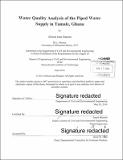Water quality analysis of the piped water supply in Tamale, Ghana
Author(s)
Hansen, Allison Jean
DownloadFull printable version (9.390Mb)
Other Contributors
Massachusetts Institute of Technology. Department of Civil and Environmental Engineering.
Advisor
Susan Murcott.
Terms of use
Metadata
Show full item recordAbstract
The United Nation's Millennium Development Goal Target 7.C is to "halve, by 2015, the proportion of the population without sustainable access to safe drinking water". While the UN claimed to have met this goal, studies have shown that the "improved" sources used as a metric to track progress do not always supply safe water. One example of these improved sources is the piped water in Tamale, Ghana, which is an intermittent system. The question raised and goal of this research is to determine whether this water source is indeed safe. The Ghana Water Company Ltd. in Tamale had handwritten notebooks containing almost ten years of water quality sample data. This data was entered into a computer database so it could be analyzed for seasonal and geographic trends as well as to gain an understanding of overall water quality. From this analysis, it was concluded that seasonal trends do impact the pH and turbidity of source water which influences the water provided to consumers. In addition, 42% of samples did not comply with accepted World Health Organization guidelines for residual free chlorine concentrations. Total coliform was present in 2% of samples. Observations of environmental factors made during field work in Tamale found five "no" answers to a sanitary survey indicating at least a medium contamination risk. Overall, these observations indicate that water from the piped network in Tamale is not always safe. Contamination also happens very readily during storage due to high usage of unsafe storage containers in Tamale combined with the low chlorine residuals.
Description
Thesis: M. Eng., Massachusetts Institute of Technology, Department of Civil and Environmental Engineering, 2014. Cataloged from PDF version of thesis. Includes bibliographical references (pages 55-56).
Date issued
2014Department
Massachusetts Institute of Technology. Department of Civil and Environmental EngineeringPublisher
Massachusetts Institute of Technology
Keywords
Civil and Environmental Engineering.